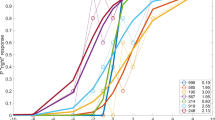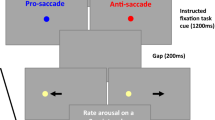Abstract
The accommodative response of 12 emmetropic subjects was measured for an array of numbers located at -1,-3 and -5 dioptres using an objective infra-red optometer. Responses were compared for passive (reading numbers) and active (adding numbers) conditions. The imposition of mental effort induced a significant increase in mean response for the -1 D stimulus, a response equivalent to the passive condition at -3 D and a reduction in response at -5 D. Mental effort induced similar responses for the -1 D and -3 D locations when sympathetic innervation to the ciliary muscle was blocked with the beta-receptor antagonist timolol maleate. Responses for the -5 D location were, however, significantly increased. It is proposed that sympathetic inhibition can modify the effect of mental effort on near accommodative responses.
Similar content being viewed by others
References
Morgan MW. Accommodation and its relationship to convergence. Am J Optom Arch Am Acad Optom 1944; 21: 183–95.
Hennessy RT, Iida T, Shiina K & Leibowitz HW. The effect of pupil size on accommodation. Vision Res 16: 587–98.
Ward PA, Charman WN. Effect of pupil size on steady-state accommodation. Vision Res 1985; 25: 1317–26.
Hamasaki D, Ong J & Marg E. The amplitude of accommodation in presbyopia. Am J Optom Arch Am Acad Optom 1956; 33: 3–14.
Johnson CA. Effects of luminance and stimulus distance on accommodation and visual resolution. J Opt Soc Am 1976; 66: 138–42.
Charman WN & Tucker J. Dependence of accommodation response on the spatial frequency spectrum of the observed object. Vision Res 1977; 17: 129–39.
Owens DA. A comparison of accommodative responsiveness and contrast sensitivity for sinusoidal gratings. Vision Res 1980; 20: 159–67.
Leibowitz HW & Owens DA. Anomalous myopias and the intermediate dark-focus of accommodation. Science 1975; 189: 646–48.
Leibowitz HW & Owens DA. New evidence for the evidence for the intermediate position of relaxed accommodation. Doc Ophthalmol 1978; 46: 133–47.
Toates FM. A model for accommodation. Vision Res 1970; 10: 1069–76.
Gilmartin B. A review of the role of sympathetic innervation of the ciliary muscle in ocular accommodation. Ophthal Physiol Opt 1986; 6; 23–37.
Törnqvist G. Effect of cervical sympathetic stimulation on accommodation in monkeys. Acta Physiol Scand 1966; 67: 363–72.
Törnqvist G. The relative importance of the parasympathetic and sympathetic nervous systems for accommodation in monkeys. Invest Ophthalmol Vis Sci 1967; 6: 612–17.
Hurwitz BS, Davidowitz J, Chin NB & Breinin GB. The effects of the sympathetic nervous system on accommodation: 1. Beta sympathetic nervous system. Arch Ophthalmol 1972; 87: 668–74.
Westheimer G. Accommodation measurements in empty visual fields. J Opt Soc Am 1957; 47: 714–18.
Miller RJ & LeBeau RC. Induced stress, situationally-specific trait anxiety and dark focus. Psychophysiol 1982; 19: 260–65.
Bullimore MA & Gilmartin B. Tonic accommodation, cognitive demand and ciliary muscle innervation. Am J Optom Physiol Opt 1987a; 64: 45–50.
Kruger PB. The effect of cognitive demand on accommodation. Am J Optom Physiol Opt 1980; 57: 440–45.
Malmstrom FV, Randle RJ, Bendix JS & Weber RJ. The visual accommodation response during concurrent mental activity. Percept Psychophys 1980; 28: 440–48.
Birnbaum MH. Nearpoint visual stress: a physiological model. J Am Optom Assoc 1984; 55: 825–35.
Gilmartin B, Hogan RE & Thompson SM. The effect of timolol maleate on tonic accommodation, tonic vergence and pupil diameter. Invest Ophthalmol Vis Sci 1984; 25: 763–70.
Gilmartin B & Hogan RE. The relationship between tonic accommodation and ciliary muscle innervation. Invest Ophthalmol Visual Sci 1985; 26: 1024–29.
Bullimore MA & Gilmartin B. The accommodative response, refractive error and mental effort: 2. Late-onset myopia. Doc Ophthalmol 1987b; in press.
McBrien NA & Millodot M. A clinical evaluation of the Canon Autoref R-1. Am J Optom Physiol Opt 1985; 62: 786–92.
Bullimore MA, Gilmartin B & Hogan RE. Objective and subjective measurment of tonic accommodation. Ophthal Physiol Opt 1986; 6: 57–62.
Baker R, Brown B & Garner L. Time course and variability of dark focus. Invest Ophthalmol Vis Sci 1983; 24: 1528–31.
Campbell FW. The depth of field of the human eye. Optica Acta 1957; 4: 157–164.
Campbell FW, Robson JG & Westheimer G. Fluctuations of accommodation under steady viewing conditions. J Physiol 1959; 145: 579–94.
Denieul P. Effect of stimulus vergence on mean accommodation response, microfluctuations of accommodation and optical quality of the human eye. Vision Res 1982; 22: 561–69.
Schor CM, Kotulak JC & Tsuetaki T. Adaptation of tonic accommodation reduces accommodative lag and is masked in darkness. Invest Ophthalmol Vis Sci 1986; 27: 820–27.
Malmstrom FV, Randle RJ, Murphy MR, Reed LR & Weber RJ. Visual fatigue: The need for an integrated model. Bull Psychonom Soc 1981; 17: 183–86.
Willemsen EW. Understanding statistical reasoning. San Francisco, Calif.: Freeman.
Cannon WB. Bodily Changes in pain, hunger, fear and rage: An account of recent researches into the function of emotional excitement. New York: Appleton, 1929.
Hess EH & Polt JM. Pupil size in relation to mental activity during simple problem-solving. Science 1964; 143: 1190–92.
Wenger MA, Jones FN & Jones MH. Physiological psychology. New York: Henry Holt & Co., 1956: 258–71.
Sternbach RA. Principles of psychology. New York: Academic Press. 1966.
Porges SW. Peripheral and neurochemical parallels of psychopathy: A psychophysiological model relating autonomic imbalance to hyperactivity, psychopathy, and autism. In: Reese HW, ed. Advances in child development and behaviour, Vol. 11. New York: Academic Press, 1976; 36–65.
Anisman H. Time-dependent variations in aversively motivated behaviours: nonassociative effects of cholinergic and catecholaminergic activity. Psychol Rev 1975; 82: 359–85.
Ruskell GL. Sympathetic innervation of the ciliary muscle in monkeys. Exp Eye Res 1973; 16: 183–90.
Gilmartin B, Bullimore MA. Sustained near-vision augments inhibitory sympathetic innervation of the ciliary muscle. Clin Vision Sci 1987; 1: 197–208.
Westheimer G & Blair SM. Accommodation of the eye during sleep and anaesthesia. Vision Res 1973; 13: 1035–40.
Miller RJ. Mood changes and the dark focus of accommodation. Percept Psychophys 1978; 24: 437–43.
Author information
Authors and Affiliations
Rights and permissions
About this article
Cite this article
Bullimore, M.A., Gilmartin, B. The accommodative response, refractive error and mental effort: 1. The sympathetic nervous system. Doc Ophthalmol 69, 385–397 (1988). https://doi.org/10.1007/BF00162751
Issue Date:
DOI: https://doi.org/10.1007/BF00162751




